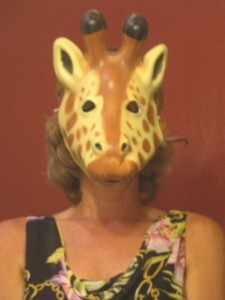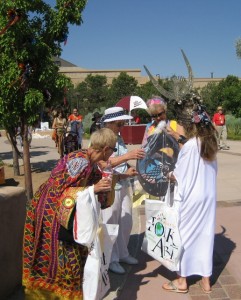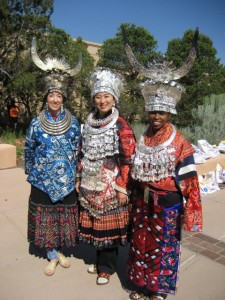Decorating with your collection

![rec381[1]](https://blog.itscactus.com/wp-content/uploads/2012/06/rec3811-85x300.jpg) How do collections get started? Maybe we’re drawn to certain images because they remind us of something special – a favorite time or place or experience. I was with my good friend, Jennifer at the San Diego Zoo one day, having an absolute ball. We were in our 40’s mind you, but I started playing with the masks at the gift shop. Holding up first the giraffe mask and then the panda mask to my face, I asked her, “Which do you like better?” To which she thoughtfully replied, “Well, the giraffe is more your color.” Immediately, I started laughing so hard I could scarcely stand up, and I bought the giraffe mask right then and there. Since then, I have bought a few other giraffe items and find myself always tempted by more.
How do collections get started? Maybe we’re drawn to certain images because they remind us of something special – a favorite time or place or experience. I was with my good friend, Jennifer at the San Diego Zoo one day, having an absolute ball. We were in our 40’s mind you, but I started playing with the masks at the gift shop. Holding up first the giraffe mask and then the panda mask to my face, I asked her, “Which do you like better?” To which she thoughtfully replied, “Well, the giraffe is more your color.” Immediately, I started laughing so hard I could scarcely stand up, and I bought the giraffe mask right then and there. Since then, I have bought a few other giraffe items and find myself always tempted by more.
By the way, I have played this all pretty close to the chest. No one really knows about my great affection for giraffes but Jennifer and me. Thus, my collection has heretofore remained modest and very manageable.
Sometimes, however, friends and relatives get wind of our affinity and suddenly, in their generosity, we find ourselves in possession of gaggles and flocks and herds and swarms. So what is one to do with a great collection gone wild? Just about every interior designer out there says that collections should be displayed as a whole, or at least in groupings within a defined area. This, they say, gives a cohesive look that defines and personalizes the space and provides the greatest visual impact. For added interest, we should try varying color, size, texture, and medium within the assembly. For example, on a shelf I could arrange my framed photo of a giraffe, my carved wooden giraffe face, and the folk art pottery giraffe, and hang my Haitian metal giraffe sculpture above them.
We must go carefully, though. Anna, author of the interior decorating DIY blog, “Take the Side Street” cautions against clutter. Ideally, she says, your display should add interest and character your home without overwhelming it. She advises, “If your collection is enormous, store and rotate the items you display as a means of keeping the whole thing fun and fresh looking.” Indeed. If a giraffe collection isn’t fresh and fun, what’s the point? I’m just so glad I don’t have to rotate things in….yet!

 For color, cultural richness, and acquisitive opportunity, you can’t beat the International Folk Art Market. Held annually the second full weekend in July in Santa Fe, NM, this year’s Market holds plenty of promise. Beyond Borders has sponsored artists in the past, and though we’re not participating as a vendor this year, it’s not because it’s not worthy. It IS! By plane, train, automobile, or on horseback, if you can make it, GO!
For color, cultural richness, and acquisitive opportunity, you can’t beat the International Folk Art Market. Held annually the second full weekend in July in Santa Fe, NM, this year’s Market holds plenty of promise. Beyond Borders has sponsored artists in the past, and though we’re not participating as a vendor this year, it’s not because it’s not worthy. It IS! By plane, train, automobile, or on horseback, if you can make it, GO!


![sm355[1]](https://blog.itscactus.com/wp-content/uploads/2012/06/sm35513.jpg)
 government steps up to protect its own.
government steps up to protect its own. A little on-line investigation revealed that it was breadfruit. Originating in the South Pacific, the species was spread throughout Oceania by intrepid islanders settling the numerous islands of Melanesia, Micronesia, and Polynesia. Due to the efforts of Captain Bligh and French voyagers, a few seedless varieties from Polynesia were introduced to the Caribbean in the late 1700s. These gradually spread to other tropical regions. Breadfruit is now grown in close to 90 countries. Countries like Haiti, apparently.
A little on-line investigation revealed that it was breadfruit. Originating in the South Pacific, the species was spread throughout Oceania by intrepid islanders settling the numerous islands of Melanesia, Micronesia, and Polynesia. Due to the efforts of Captain Bligh and French voyagers, a few seedless varieties from Polynesia were introduced to the Caribbean in the late 1700s. These gradually spread to other tropical regions. Breadfruit is now grown in close to 90 countries. Countries like Haiti, apparently. The trees begin bearing fruit in 3 to 5 years and are productive for many decades. They require little attention or care, and can be grown under a wide range of ecological conditions. Throughout its range, breadfruit is grown in home gardens and small farms interplanted with a mix of subsistence crops, cash crops, and other useful plants. The trees form a protective overstory providing shade, mulch, and a beneficial microclimate. Cultivating breadfruit trees protects watersheds; replacing slash-and-burn agriculture and field cropping with a permanent tree cover. What a wonderful crop to plant in Haiti, where deforestation is at a whopping 98% and watershed damage due to erosion is tremendous.
The trees begin bearing fruit in 3 to 5 years and are productive for many decades. They require little attention or care, and can be grown under a wide range of ecological conditions. Throughout its range, breadfruit is grown in home gardens and small farms interplanted with a mix of subsistence crops, cash crops, and other useful plants. The trees form a protective overstory providing shade, mulch, and a beneficial microclimate. Cultivating breadfruit trees protects watersheds; replacing slash-and-burn agriculture and field cropping with a permanent tree cover. What a wonderful crop to plant in Haiti, where deforestation is at a whopping 98% and watershed damage due to erosion is tremendous.